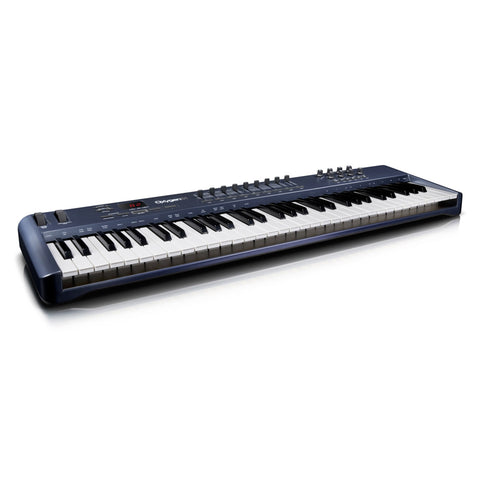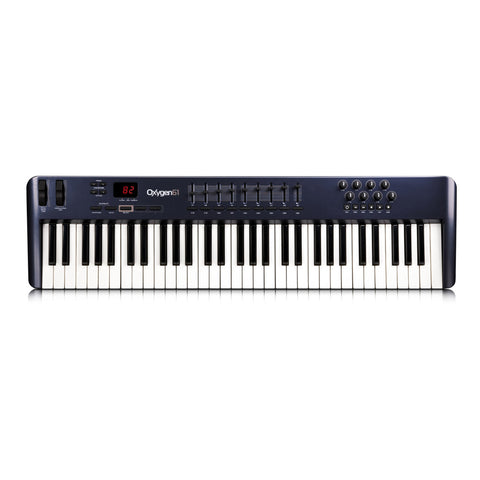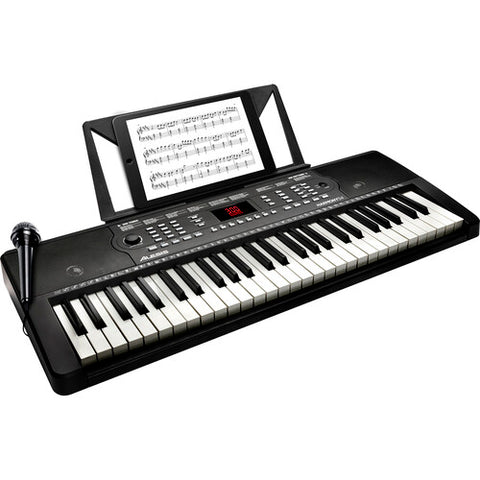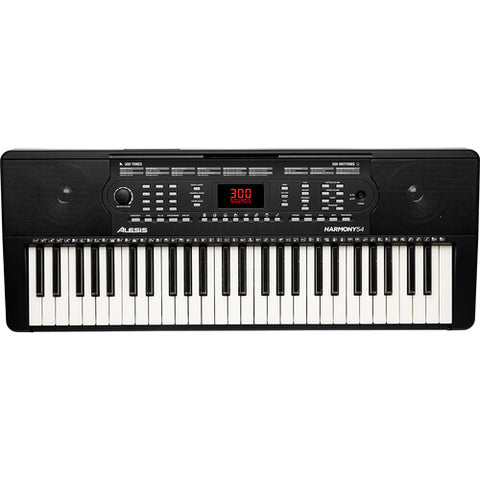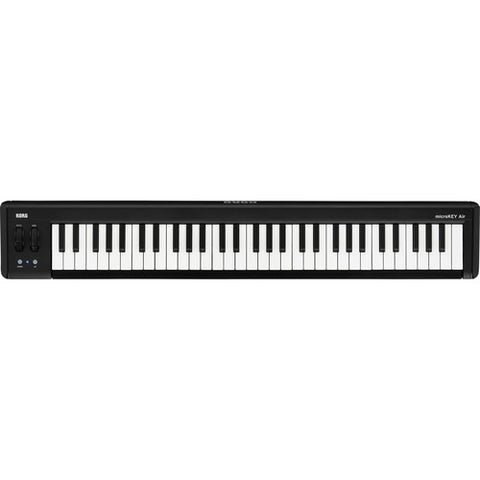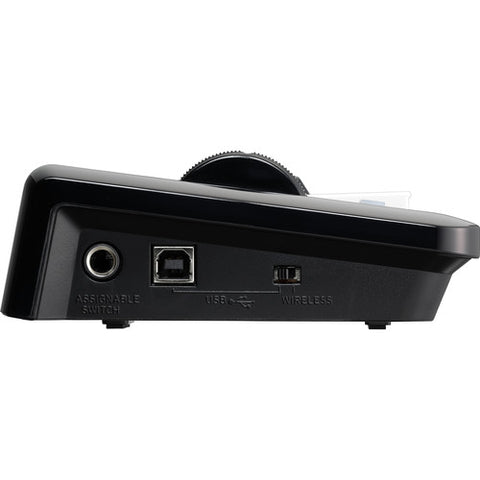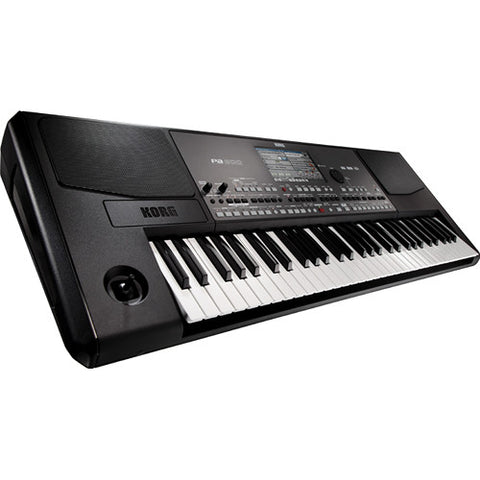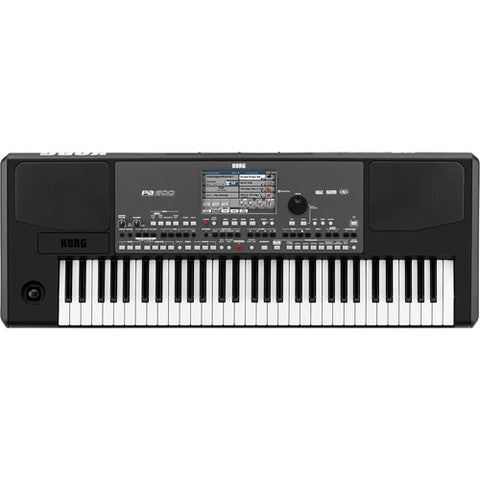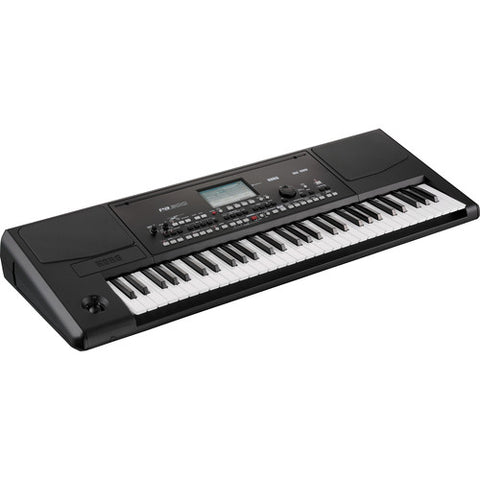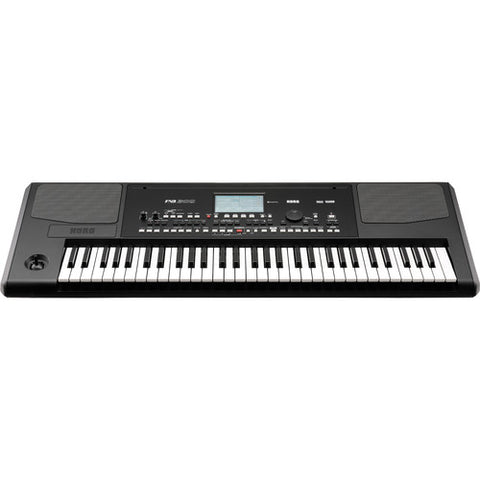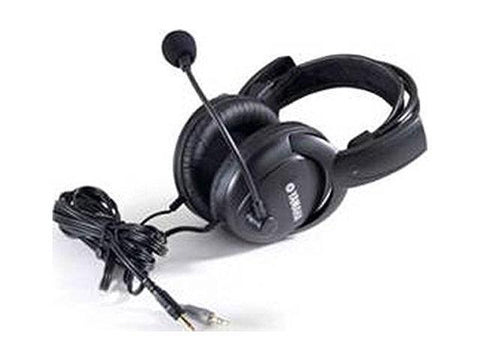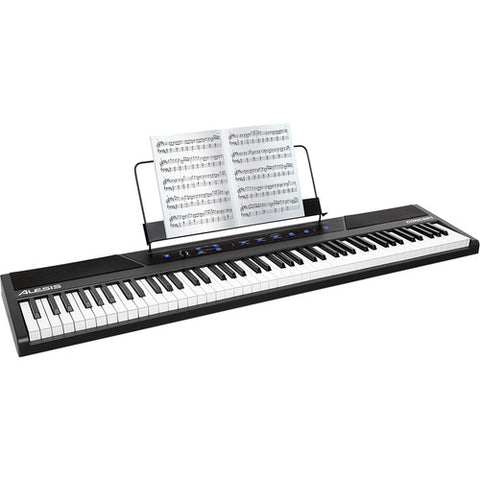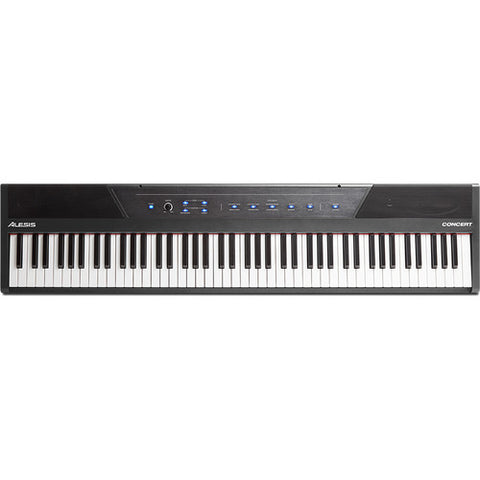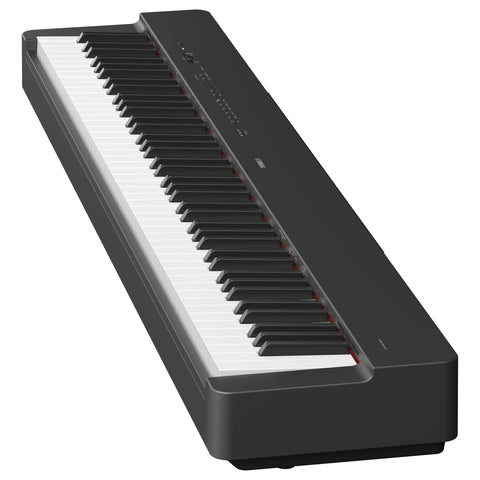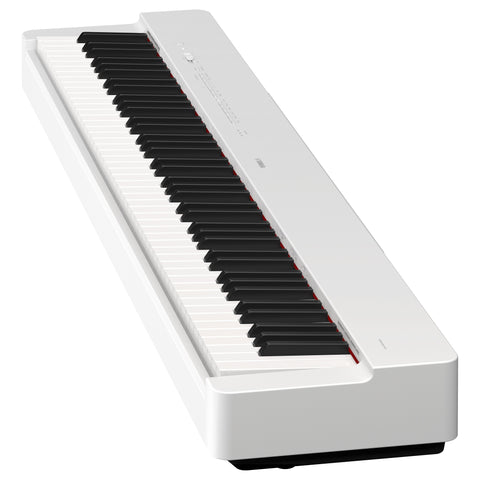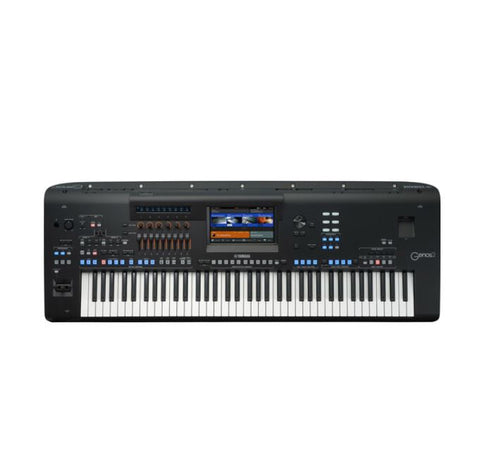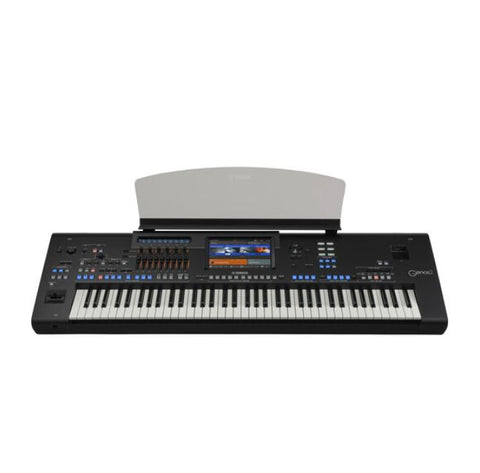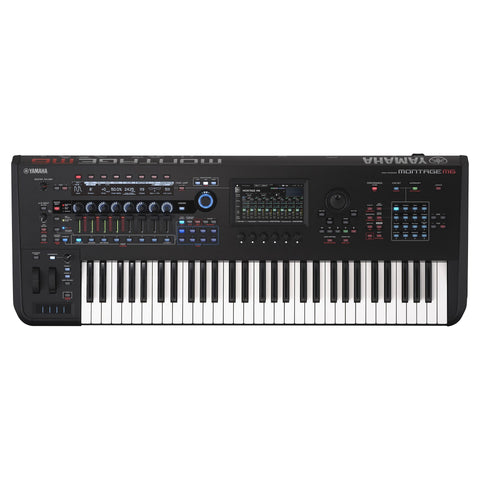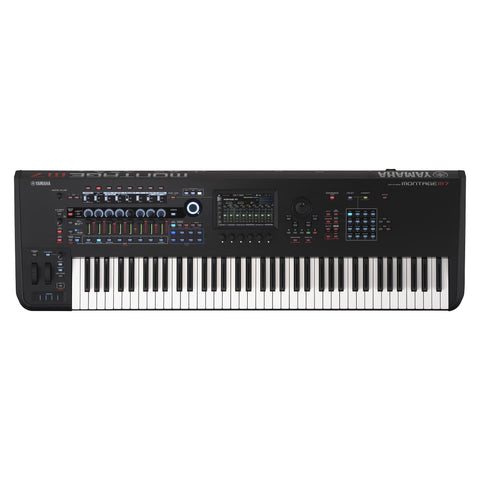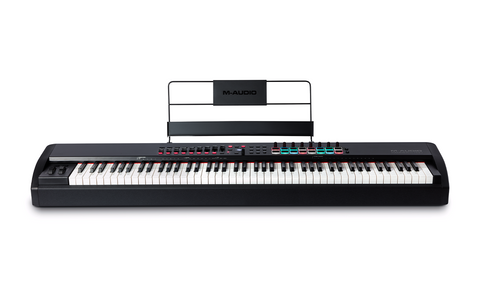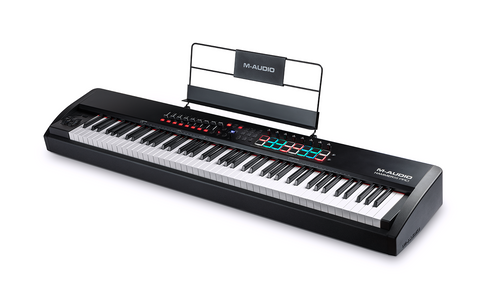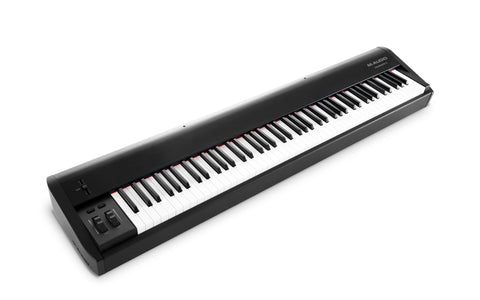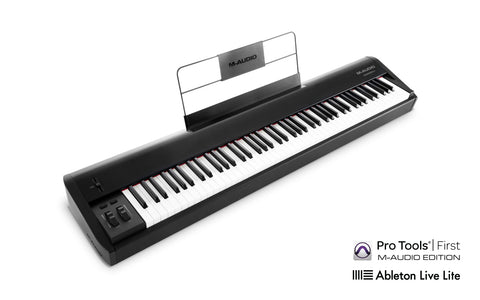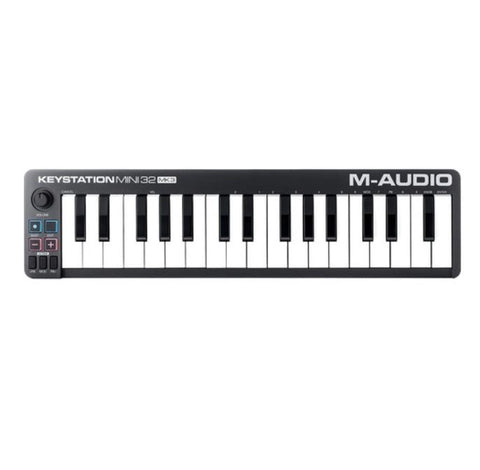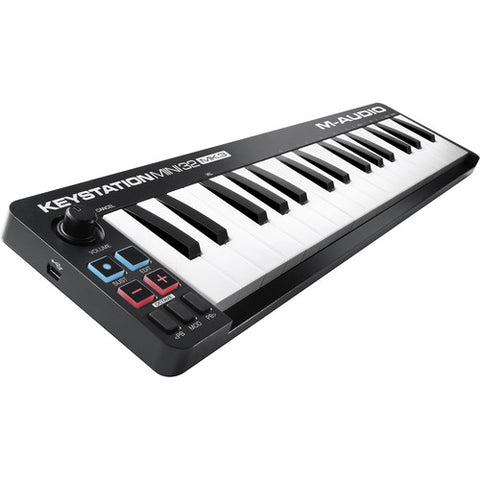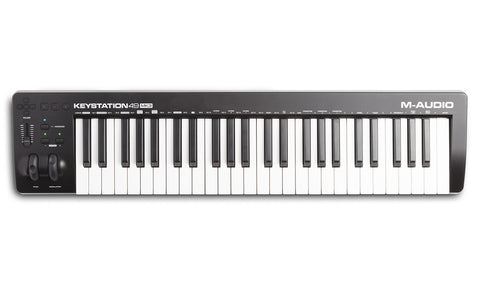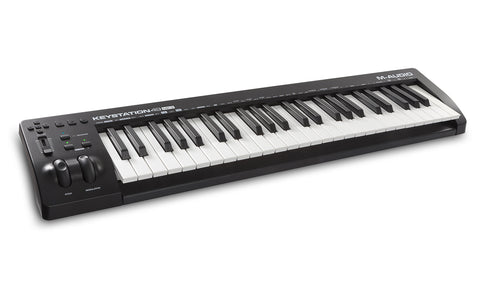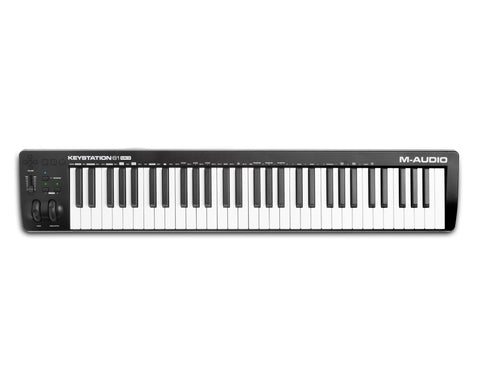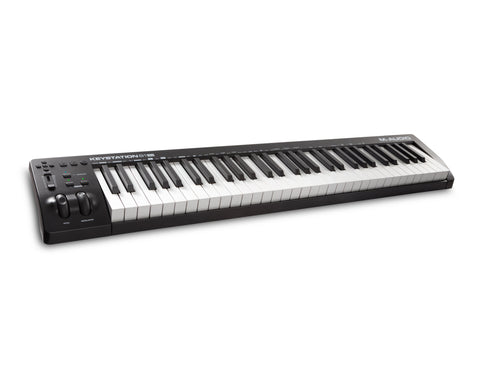KORG KRONOS288LS KRONOS with New Light Touch 88-Note Action and Lighter Body
Vendor: KORG
Available

KORG KRONOS288LS KRONOS with New Light Touch 88-Note Action and Lighter Body
The KRONOS 88 LS Music Workstation professionally designed by KORG is a full-sized keyboard that has been designed along with a light-touch keyboard intended for effortless playability. It is possible to be used in several environments by musicians, sound designers, and engineers for use in live stage, recording studio, theater, and rehearsal applications.
The mechanism of the keyboard has been redesigned so that the velocity is easier to control than on existing light-touch keyboards. The box-shaped keys share their look with KORG's premium RH3-action keyboard but deliver a lighter, faster-playing feel, like that of a synth keyboard.
The KRONOS 88 LS is weighing under 40 pounds, that makes the transport and setup more convenient. In addition to the dynamic keyboard, the KRONOS LS comes featuring v3.1 software, which is capable of offering Quick Layer and Quick Split functions right at your fingertips. Additional OS refinements are made for ensuring the stability and for providing a stress-free performance environment.
Light-Touch Keyboard for Faster Playing
The revamped light-touch keys is making it easy to play anything from rapid organ licks to synth phrases to glissandi. The keyboard mechanism has been redesigned so the velocity is easier to control than on existing light-touch keyboards. Since the keyboard is semi-weighted, it's suitable for playing piano and electric piano in any style.
Lighter for Increased Portability
The LS keyboard is made semi-weighted and lighter than the KRONOS 2 88's RH3 keyboard. It comes along with a weight of just under 40 lb; this is making the transport and setup much easier.
OS v3.1 Includes Quick Layer/Split Functions
Featuring OS v3.1, the KRONOS LS comes featuring quick layer and quick split functions right at your fingertips. Create layers such as piano and strings, or splits such as electric piano and bass. Several additional OS refinements have also been made for ensuring the stability and a stress-free performance environment.
A Fresh Look to Complement The New Feel
With its dark umber aluminum body and sunburst wood side panels, KRONOS LS is designed to to look as good as it feels.
KORG · S000 Berlin City Tour
| System | Kronos System ver. 3.1 |
| Keyboard | LS semi-weighted, velocity-sensitive, no aftertouch |
| Synthesis Types | 9 HD-1 High-Definition synthesizer (PCM) AL-1 Analog Synthesizer (analog modeling) CX-3 Tonewheel Organ (tonewheel organ modeling) STR-1 Plucked String (physical modeling) MS-20EX Component Modeling technology (analog modeling) PolysixEX Component Modeling Technology (analog modeling) MOD-7 Waveshaping VPM Synthesizer (VPM synthesis) SGX-2 Premium Piano (acoustic piano) EP-1 MDS Electric Piano (electric piano) |
| Maximum Polyphony | HD-1: 140 voices AL-1: 80 voices CX-3: 200 voices STR-1 40 voices MS-20EX: 40 voices PolysixEX: 180 voices MOD-7: 52 voices SGX-2: 100 voices EP-1: 104 voices |
| PCM Memory | Preset: 314 MB (ROM: 1505 multisamples, 1388 drum samples) |
| Build-in Expansion PCM Libraries | EXs1 ROM Expansion EXs2 Concert Grand Piano EXs3 Brass & Woodwinds EXs4 Vintage Keyboards EXs5 ROM Expansion 2 EXs6 SGX-1 German D Piano EXs7 SGX-1 Japanese C Piano EXs8 Rock Ambience Drums EXs9 Jazz Ambience Drums EXs17 SGX-2 Berlin D Piano EXs18 KORG EXs Collections |
| Program Capacity | RAM: Approximately 2 GB |
| Wave Sequences | Preloaded: 187 wave sequences User Memory: 598 wave sequences |
| HD-1 Program | Advanced Vector Synthesis: Control oscillator volumes and synthesis & effects parameters via the Vector joystick and the tempo-synchronized vector envelope Structure: Single: Only OSC1 Double: OSC1 and OSC2 Double mode lets you layer two completely separate synth voices, each with its own velocity-switched oscillator, dual filter, EGs, LFOs, etc Drums: One drum kit, Double Drums: Two drum kits Oscillator: Virtual Memory Technology (VMT) plays large samples directly from the internal SSD 8 velocity zones per oscillator, with switching, crossfades and layering. Each zone can play mono or stereo multisamples or wave sequences Filters: Two multi-mode filters per voices (low-pass, high-pass, band-pass, and band- reject), Four-mode filter routings (single, serial, parallel, and 24 dB mode) Driver: Per voice non-linear driver and low boost circuit EQ: Three bands, with sweepable mid Modulation: Three envelope generators, two LFOs per voice, common LFO, four key-tracking generators, AMS (Alternate Modulation Source), two AMS mixers |
| EXi Program Common | Advanced Vector Synthesis: Control oscillator volumes and synthesis & effects parameters via the Vector joystick and the tempo-synchronized Vector envelope Modulation: Common Step Sequencer, AMS (Alternate Modulation Source), Common LFO, 2 key-tracking generators EQ: Three bands, with sweepable mid |
| AL-1 Program | Oscillators: Ultra-low-aliasing oscillators OSC1, OSC2, Sub-oscillator, and noise generator; ring modulation, FM and Sync Audio input: External audio can be processed through the ring modulator, filter, driver, amp, and EQ Filters: 2 x multi-mode filter (low-pass, high-pass, band-pass, and band-reject) with four types of filter routings (single, serial, parallel, and 24 dB mode), MultiFilter mode (only Filter-A; modulatable mix of low pass, high pass, band pass, and dry input, for creating a wide variety of unique filter types and effects) Driver: Per-voice, non-linear driver and low boost circuit Modulation: Five envelope generators, four per-voice LFOs, two key track generators, two AMS mixers, Per-voice step sequencer. |
| CX-3 Program | Tonewheel organ modeling: Phase-synchronous tonewheels (clean and vintage modes), percussion, key click, wheel brake EX mode: Four additional, user-specified drawbars, and expanded percussion Internal effects: Rotary speaker, vibrato/chorus, amp modeling with overdrive, 3-band EQ Drawbar control: Controlled via nine front-panel sliders (via Tone Adjust) Split: Upper, lower Modulation: Two AMS mixers |
| STR-1 Program | Physically modeled string: Includes physically modeled damping, decay, dispersion, nonlinearity, harmonics, dual pickups,and more. Most string parameters can be controlled in real time String excitation: Three independent excitation sources can be used simultaneously—Pluck, Noise, and PCM 16 preset "pluck" types, with modulatable width and randomization Noise generator with saturation and dedicated lowpass filter PCM oscillator: KORG's ultra-low-aliasing technology, as introduced in the HD-1 4 velocity zones per oscillator Uses any mono multisamples including ROM, EXs, user sample bank, or Sampling mode. Supports virtual memory PCM can either be used as an excitation signal, or layered with the output of the string. Excitation Filter: Dedicated 2-pole multimode filter for shaping the string excitation. Filter can be enabled/disabled separately for each excitation source. Low Pass, High Pass, Band Pass, and Band Reject modes. Audio Input and Feedback: Run real-time audio through the string, including feedback through effects. Modeled feedback includes modulateable instrument-to-amp distance and orientation. Filters: Dual multi-mode filters per voice; Single, Serial, Parallel (with split stereo output), and 24 dB (4-pole) configurations. Low Pass, High Pass, and Band Reject modes. Multi Filter mode (Filter A only): Modulatable mix of Low Pass, High Pass, Band Pass, and dry input, for creating a wide variety of unique filter types and effects. Modulation: 5 envelopes, 4 per-voice LFOs, 2 Key Track generators, String Tracking generators, 4 AMS mixers. |
| MS-20EX Program | Oscillators: Ultra-low-aliasing oscillators VCO1, VCO2, Ring Mod, Pink and White Noise Generator Audio Input: Run real-time audio through the synthesis engine and ESP (External Signal Processor) Filters: 12 dB/octave High Pass and Low Pass self-resonant filters ESP section: 24 dB/octave Low-Cut and High-Cut filters, available per voiceESP (External Signal Processor) Use incoming audio as a trigger and/or CV source Modulation: Original DAR and HADSR EGs 1 & 2, original MG (with MIDI sync), Sample-and-Hold, MVCA KRONOS modulation: 4 x additional multi-stage Envelopes, 4 x additional per-voice LFOs, and 4 x AMS Mixers Patch Panel Patchable audio and modulation, at audio rates Patch Points: Keyboard: Keyboard CV Out, Keyboard Trigger Out, VCO1+VCO2 CV In, VCO2 CV In VCO: VCO1 + VCO2 External Frequency Control In, VCO1 Out, VCO2 Out VCF: External Signal In, External HP Filter Cutoff Frequency Control In, External LP Filter CutoffFrequency Control In, HPF Out, LPF In, LPF Out VCO+VCF: Total External Modulation In VCA: External Initial Gain Control In, VCA In EG: EG1 Envelope Signal Normal Out, EG1 Envelope Signal Reverse Out, EG1+EG2 Trigger In, EG1Trigger In, EG2 Envelope Signal Reverse Out MG: Triangle Out, Rectangle Out Noise Generator: Pink Noise Out, White Noise Out Sample and Hold: Clock Trigger In, Sample Signal In, S/H Out Modulation VCA: Control Voltage In, Signal In, Signal OutManual Controller Control Wheel Out, Momentary Switch ESP: Signal In, AMP Out, BPF In, BPF Out, F-V CV Out, Envelope Out, Trigger Out Others: EXi Audio In, Mixer 1 In, Mixer 1 Out, Mixer 2 In, Mixer 2 Out |
| PolysixEX Program | Oscillators: VCO: Saw, Pulse, PWM Sub Oscillator: Off, one octave below, 2 octaves below Filter: 24 dB (4-Pole) Low-Pass self-resonant filter Effects: Integrated Polysix Chorus, Phase, and Ensemble Arpeggiator: Integrated MIDI-synced arpeggiator with adjustable Range, Mode, and Latch Polysix Modulation: Original ADSR EG and MG (with MIDI sync) KRONOS Modulation: 2 additional multi-stage Envelopes, 2 additional per-voice LFOs, and 4 AMS Mixers |
| MOD-7 Program | Waveshaping VPM Synthesizer: Combines Variable Phase Modulation (VPM), waveshaping ring modulation, PCM sample playback, and subtractive synthesis, able to convert-load SYX files Oscillators: 6 x VPM/Waveshaper/Ring Modulation Oscillators Phase and modulatable pitch per oscillator 101 Waveshaper tables plus modulatable Drive and Offset Use as oscillators, or as Waveshapers or Ring Modulators for other signals PCM Oscillator: KORG's ultra-low-aliasing technology, as introduced in the HD-1 4 x velocity zones per oscillator Uses any mono Multisamples, including ROM, EXs, User Sample Bank, or Sampling Mode. Supports Virtual Memory PCM can be used as an FM modulator and/or layered with the VPM Oscillators Noise generator with saturation and dedicated low pass filter Audio Input: Run real-time audio through the VPM Oscillators and filters Filters: Dual multi-mode filters per voice (Low Pass, High Pass, Band Pass, and Band Reject modes) Two types of filter routing: Parallel and 24-dB Multi Filter mode (Filter A only): Modulatable mix of Low Pass, High Pass, Band Pass, and dry input, for creating a wide variety ofunique filter types and effects Patch Panel: Supports both algorithm (78 types) selection and free patching Three 2-in, 1-out mixers for scaling and merging audio, fully modulatable, with phase inversion Main 6-input stereo mixer, with modulatable pan and volume, plus phase inversion Modulation: 10 Envelopes, 4 per-voice LFOs, 9 Key Tracking generators, Per-voice Step Sequencer, 4 standardAMS Mixers plus 4 simple AMS Mixers |
| SGX-2 Program | Premium Piano: Virtual Memory Technology (VMT) plays large samples directly from the internal SSD Chromatically sampled at up to 12 velocity levels, no looping Damper resonance and mechanical noise Modeled String Resonance Una Corda sample support PCM: EXs6 - SGX-1 German D Piano, EXs7 - SGX-1 Japanese C Piano, and optional EXs12: SGX-1 Austrian DPiano (8 velocity levels, no Una Corda samples); EXs17 - Berlin D Piano (12 velocity levels, includesUna Corda samples) Piano Type: 64 or more Oscillator Control: Damper Resonance, Damper Noise, Mechanical Noise, Note Release, String Resonance |
| Disk Mode | Load, save, utility, audio CD burning, audio CD playback, data filer function (save/load MIDI SystemExclusive data), CD-R/RW (UDF format read/write), ISO9660 Level 1 |
| Controllers | Vector joystick, joystick, ribbon controller, switches 1 & 2 Control Surface: Control Assign Switches: Assigns the Control Surface to Timber/Track, Audio,External, Realtime Knobs/KARMA, Tone Adjust/EQMixer Knobs Switch: Assigns the Mixer Knobs to either Channel Strip orIndividual Pan, Reset Control Switch, Solo Switch, Knobs 1-8, Switches 1-8(Upper Row), Switches 1-8 (Lower Row), Sliders 1-8, Master SliderKARMA Control: On/Off, Latch, Module Control KARMA Controller Section: Switches = ON/OFF, LATCH, MODULE CONTROL DRUM TRACK Controller Section: Switches = On/Off |
| Display | TouchView graphical user interface, 8" TFT, SVGA (800 x 600 dots), adjustable brightness |
| Frequency Response | 20 Hz to 22 kHz, ±1.0 dB, 10 kOhms load |
| Total Harmonic Distortion (THD) + N | 20 Hz to 22 kHz, 0.01%, 10 kOhms (typical) |
| Signal to Noise Ratio | 95 dB (typical) |
| Dynamic Range | 95 dB (typical) |
| Crosstalk | 95 dB, at 1 kHz (typical) |
| Analog | Main L/Mono, R: 2 x 1/4" /6.3 mm TRS Balanced Individual: 4 x 1/4" / 6.3 mm TRS Balanced Output Impedance: 350 Ohms stereo; 175 Ohms mono (L/Mono only) Nominal Level: +4 dBu Maximum Level: +16 dBu Load Impedance: 600 or greater Main volume knob controls only Main Audio Output only Headphones:1/4" / 6.3 mm TRS stereo phone jack Headphone Output Impedance: 33 Ohms at maximum headphone level of 60 + 60 mW Main volume knob (link with audio output main) |
| Digital | Optical S/PDIF: Format: 24-bit, S/PDIF IEC60958, EIAJCP-1201 Sample Rate: 48 kHz Digital output of the same signals as audio output (Main) L/Mono and R USB B: Format: 24-bit Sample Rate: 48 kHz 2 channels (digital output of the same signals as Main Audio Output) |
| Analog | Audio Inputs 1,2: 2 x 1/4" (6.3 mm) TRS balanced 2 x Mic/Line input level switches, Level knobs Input Impedance: 10 kOhms Nominal Level: line +4 dBu (Level knob = min), -36 dBu (Level knob = max) Nominal Level: Mic -22 dBu (Level knob = min), -62 dBu (Level knob = max) Maximum Level: Line +16 dBu (Level knob = min), -24 dBu (Level knob = max) Maximum Level: Mic -10 dBu (Level knob = min), -50 dBu (Level knob = max) Source Impedance: 600 Ohms Signal to Noise Ratio: 95 dB (typical) Dynamic Range: 95 dB (typical) Crosstalk: 95 dB, at 1 kHz (typical) |
| Digital | Optical S/PDIF Format: 24-bit Sample Rate: 48 kHz USB B: Format: 24-bit Sample Rate: 48 kHz 2 x channels |
| Control Input | Damper (half damper supported) Assignable switch, assignable pedal |
| MIDI | In, Out, Thru |
| USB | 2 x USB A (Type A) for connection to QWERTY keyboards, MIDI controllers, Ethernet adapters, and storage devices 1 x USB B (Type B) MIDI/audio interface MIDI: 1 (16 channel) input / 1 (16 channel) output Audio: 2 channel input / 2 channel output 2 x USB 2.0 high-speed ports (supports 480 Mbps) |
| Disk Drives | 60 GB SSD (2.5"); optional installation of second internal SSD |
| Power | AC power supply terminal, power On/Off switch |
| Power Consumption | 60 W |
| Dimensions (W x D x H) | 56.14 x 14.33 x 5.28" / 1426 x 364 x 134 mm |
| Weight | 39.24 lb / 17.8 kg |
| Synthesis Types | 9 HD-1 High-Definition synthesizer (PCM) AL-1 Analog Synthesizer (analog modeling) CX-3 Tonewheel Organ (tonewheel organ modeling) STR-1 Plucked String (physical modeling) MS-20EX Component Modeling technology (analog modeling) PolysixEX Component Modeling Technology (analog modeling) MOD-7 Waveshaping VPM Synthesizer (VPM synthesis) SGX-2 Premium Piano (acoustic piano) EP-1 MDS Electric Piano (electric piano) |
| Maximum Polyphony | HD-1: 140 voices AL-1: 80 voices CX-3: 200 voices STR-1 40 voices MS-20EX: 40 voices PolysixEX: 180 voices MOD-7: 52 voices SGX-2: 100 voices EP-1: 104 voices |
| PCM Memory | Preset: 314 MB (ROM: 1505 multisamples, 1388 drum samples) |
| Build-in Expansion PCM Libraries | EXs1 ROM Expansion EXs2 Concert Grand Piano EXs3 Brass & Woodwinds EXs4 Vintage Keyboards EXs5 ROM Expansion 2 EXs6 SGX-1 German D Piano EXs7 SGX-1 Japanese C Piano EXs8 Rock Ambience Drums EXs9 Jazz Ambience Drums EXs17 SGX-2 Berlin D Piano EXs18 KORG EXs Collections |
| Program Capacity | RAM: Approximately 2 GB |
| Wave Sequences | Preloaded: 187 wave sequences User Memory: 598 wave sequences |
| HD-1 Program | Advanced Vector Synthesis: Control oscillator volumes and synthesis & effects parameters via the Vector joystick and the tempo-synchronized vector envelope Structure: Single: Only OSC1 Double: OSC1 and OSC2 Double mode lets you layer two completely separate synth voices, each with its own velocity-switched oscillator, dual filter, EGs, LFOs, etc Drums: One drum kit, Double Drums: Two drum kits Oscillator: Virtual Memory Technology (VMT) plays large samples directly from the internal SSD 8 velocity zones per oscillator, with switching, crossfades and layering. Each zone can play mono or stereo multisamples or wave sequences Filters: Two multi-mode filters per voices (low-pass, high-pass, band-pass, and band- reject), Four-mode filter routings (single, serial, parallel, and 24 dB mode) Driver: Per voice non-linear driver and low boost circuit EQ: Three bands, with sweepable mid Modulation: Three envelope generators, two LFOs per voice, common LFO, four key-tracking generators, AMS (Alternate Modulation Source), two AMS mixers |
| EXi Program Common | Advanced Vector Synthesis: Control oscillator volumes and synthesis & effects parameters via the Vector joystick and the tempo-synchronized Vector envelope Modulation: Common Step Sequencer, AMS (Alternate Modulation Source), Common LFO, 2 key-tracking generators EQ: Three bands, with sweepable mid |
| AL-1 Program | Oscillators: Ultra-low-aliasing oscillators OSC1, OSC2, Sub-oscillator, and noise generator; ring modulation, FM and Sync Audio input: External audio can be processed through the ring modulator, filter, driver, amp, and EQ Filters: 2 x multi-mode filter (low-pass, high-pass, band-pass, and band-reject) with four types of filter routings (single, serial, parallel, and 24 dB mode), MultiFilter mode (only Filter-A; modulatable mix of low pass, high pass, band pass, and dry input, for creating a wide variety of unique filter types and effects) Driver: Per-voice, non-linear driver and low boost circuit Modulation: Five envelope generators, four per-voice LFOs, two key track generators, two AMS mixers, Per-voice step sequencer. |
| CX-3 Program | Tonewheel organ modeling: Phase-synchronous tonewheels (clean and vintage modes), percussion, key click, wheel brake EX mode: Four additional, user-specified drawbars, and expanded percussion Internal effects: Rotary speaker, vibrato/chorus, amp modeling with overdrive, 3-band EQ Drawbar control: Controlled via nine front-panel sliders (via Tone Adjust) Split: Upper, lower Modulation: Two AMS mixers |
| STR-1 Program | Physically modeled string: Includes physically modeled damping, decay, dispersion, nonlinearity, harmonics, dual pickups,and more. Most string parameters can be controlled in real time String excitation: Three independent excitation sources can be used simultaneously—Pluck, Noise, and PCM 16 preset "pluck" types, with modulatable width and randomization Noise generator with saturation and dedicated lowpass filter PCM oscillator: KORG's ultra-low-aliasing technology, as introduced in the HD-1 4 velocity zones per oscillator Uses any mono multisamples including ROM, EXs, user sample bank, or Sampling mode. Supports virtual memory PCM can either be used as an excitation signal, or layered with the output of the string. Excitation Filter: Dedicated 2-pole multimode filter for shaping the string excitation. Filter can be enabled/disabled separately for each excitation source. Low Pass, High Pass, Band Pass, and Band Reject modes. Audio Input and Feedback: Run real-time audio through the string, including feedback through effects. Modeled feedback includes modulateable instrument-to-amp distance and orientation. Filters: Dual multi-mode filters per voice; Single, Serial, Parallel (with split stereo output), and 24 dB (4-pole) configurations. Low Pass, High Pass, and Band Reject modes. Multi Filter mode (Filter A only): Modulatable mix of Low Pass, High Pass, Band Pass, and dry input, for creating a wide variety of unique filter types and effects. Modulation: 5 envelopes, 4 per-voice LFOs, 2 Key Track generators, String Tracking generators, 4 AMS mixers. |
| MS-20EX Program | Oscillators: Ultra-low-aliasing oscillators VCO1, VCO2, Ring Mod, Pink and White Noise Generator Audio Input: Run real-time audio through the synthesis engine and ESP (External Signal Processor) Filters: 12 dB/octave High Pass and Low Pass self-resonant filters ESP section: 24 dB/octave Low-Cut and High-Cut filters, available per voiceESP (External Signal Processor) Use incoming audio as a trigger and/or CV source Modulation: Original DAR and HADSR EGs 1 & 2, original MG (with MIDI sync), Sample-and-Hold, MVCA KRONOS modulation: 4 x additional multi-stage Envelopes, 4 x additional per-voice LFOs, and 4 x AMS Mixers Patch Panel Patchable audio and modulation, at audio rates Patch Points: Keyboard: Keyboard CV Out, Keyboard Trigger Out, VCO1+VCO2 CV In, VCO2 CV In VCO: VCO1 + VCO2 External Frequency Control In, VCO1 Out, VCO2 Out VCF: External Signal In, External HP Filter Cutoff Frequency Control In, External LP Filter CutoffFrequency Control In, HPF Out, LPF In, LPF Out VCO+VCF: Total External Modulation In VCA: External Initial Gain Control In, VCA In EG: EG1 Envelope Signal Normal Out, EG1 Envelope Signal Reverse Out, EG1+EG2 Trigger In, EG1Trigger In, EG2 Envelope Signal Reverse Out MG: Triangle Out, Rectangle Out Noise Generator: Pink Noise Out, White Noise Out Sample and Hold: Clock Trigger In, Sample Signal In, S/H Out Modulation VCA: Control Voltage In, Signal In, Signal OutManual Controller Control Wheel Out, Momentary Switch ESP: Signal In, AMP Out, BPF In, BPF Out, F-V CV Out, Envelope Out, Trigger Out Others: EXi Audio In, Mixer 1 In, Mixer 1 Out, Mixer 2 In, Mixer 2 Out |
| PolysixEX Program | Oscillators: VCO: Saw, Pulse, PWM Sub Oscillator: Off, one octave below, 2 octaves below Filter: 24 dB (4-Pole) Low-Pass self-resonant filter Effects: Integrated Polysix Chorus, Phase, and Ensemble Arpeggiator: Integrated MIDI-synced arpeggiator with adjustable Range, Mode, and Latch Polysix Modulation: Original ADSR EG and MG (with MIDI sync) KRONOS Modulation: 2 additional multi-stage Envelopes, 2 additional per-voice LFOs, and 4 AMS Mixers |
| MOD-7 Program | Waveshaping VPM Synthesizer: Combines Variable Phase Modulation (VPM), waveshaping ring modulation, PCM sample playback, and subtractive synthesis, able to convert-load SYX files Oscillators: 6 x VPM/Waveshaper/Ring Modulation Oscillators Phase and modulatable pitch per oscillator 101 Waveshaper tables plus modulatable Drive and Offset Use as oscillators, or as Waveshapers or Ring Modulators for other signals PCM Oscillator: KORG's ultra-low-aliasing technology, as introduced in the HD-1 4 x velocity zones per oscillator Uses any mono Multisamples, including ROM, EXs, User Sample Bank, or Sampling Mode. Supports Virtual Memory PCM can be used as an FM modulator and/or layered with the VPM Oscillators Noise generator with saturation and dedicated low pass filter Audio Input: Run real-time audio through the VPM Oscillators and filters Filters: Dual multi-mode filters per voice (Low Pass, High Pass, Band Pass, and Band Reject modes) Two types of filter routing: Parallel and 24-dB Multi Filter mode (Filter A only): Modulatable mix of Low Pass, High Pass, Band Pass, and dry input, for creating a wide variety ofunique filter types and effects Patch Panel: Supports both algorithm (78 types) selection and free patching Three 2-in, 1-out mixers for scaling and merging audio, fully modulatable, with phase inversion Main 6-input stereo mixer, with modulatable pan and volume, plus phase inversion Modulation: 10 Envelopes, 4 per-voice LFOs, 9 Key Tracking generators, Per-voice Step Sequencer, 4 standardAMS Mixers plus 4 simple AMS Mixers |
| SGX-2 Program | Premium Piano: Virtual Memory Technology (VMT) plays large samples directly from the internal SSD Chromatically sampled at up to 12 velocity levels, no looping Damper resonance and mechanical noise Modeled String Resonance Una Corda sample support PCM: EXs6 - SGX-1 German D Piano, EXs7 - SGX-1 Japanese C Piano, and optional EXs12: SGX-1 Austrian DPiano (8 velocity levels, no Una Corda samples); EXs17 - Berlin D Piano (12 velocity levels, includesUna Corda samples) Piano Type: 64 or more Oscillator Control: Damper Resonance, Damper Noise, Mechanical Noise, Note Release, String Resonance |
| Disk Mode | Load, save, utility, audio CD burning, audio CD playback, data filer function (save/load MIDI SystemExclusive data), CD-R/RW (UDF format read/write), ISO9660 Level 1 |
| Controllers | Vector joystick, joystick, ribbon controller, switches 1 & 2 Control Surface: Control Assign Switches: Assigns the Control Surface to Timber/Track, Audio,External, Realtime Knobs/KARMA, Tone Adjust/EQMixer Knobs Switch: Assigns the Mixer Knobs to either Channel Strip orIndividual Pan, Reset Control Switch, Solo Switch, Knobs 1-8, Switches 1-8(Upper Row), Switches 1-8 (Lower Row), Sliders 1-8, Master SliderKARMA Control: On/Off, Latch, Module Control KARMA Controller Section: Switches = ON/OFF, LATCH, MODULE CONTROL DRUM TRACK Controller Section: Switches = On/Off |
| Display | TouchView graphical user interface, 8" TFT, SVGA (800 x 600 dots), adjustable brightness |
| Frequency Response | 20 Hz to 22 kHz, ±1.0 dB, 10 kOhms load |
| Total Harmonic Distortion (THD) + N | 20 Hz to 22 kHz, 0.01%, 10 kOhms (typical) |
| Signal to Noise Ratio | 95 dB (typical) |
| Dynamic Range | 95 dB (typical) |
| Crosstalk | 95 dB, at 1 kHz (typical) |
| Analog | Main L/Mono, R: 2 x 1/4" /6.3 mm TRS Balanced Individual: 4 x 1/4" / 6.3 mm TRS Balanced Output Impedance: 350 Ohms stereo; 175 Ohms mono (L/Mono only) Nominal Level: +4 dBu Maximum Level: +16 dBu Load Impedance: 600 or greater Main volume knob controls only Main Audio Output only Headphones:1/4" / 6.3 mm TRS stereo phone jack Headphone Output Impedance: 33 Ohms at maximum headphone level of 60 + 60 mW Main volume knob (link with audio output main) |
| Digital | Optical S/PDIF: Format: 24-bit, S/PDIF IEC60958, EIAJCP-1201 Sample Rate: 48 kHz Digital output of the same signals as audio output (Main) L/Mono and R USB B: Format: 24-bit Sample Rate: 48 kHz 2 channels (digital output of the same signals as Main Audio Output) |
| Analog | Audio Inputs 1,2: 2 x 1/4" (6.3 mm) TRS balanced 2 x Mic/Line input level switches, Level knobs Input Impedance: 10 kOhms Nominal Level: line +4 dBu (Level knob = min), -36 dBu (Level knob = max) Nominal Level: Mic -22 dBu (Level knob = min), -62 dBu (Level knob = max) Maximum Level: Line +16 dBu (Level knob = min), -24 dBu (Level knob = max) Maximum Level: Mic -10 dBu (Level knob = min), -50 dBu (Level knob = max) Source Impedance: 600 Ohms Signal to Noise Ratio: 95 dB (typical) Dynamic Range: 95 dB (typical) Crosstalk: 95 dB, at 1 kHz (typical) |
| Digital | Optical S/PDIF Format: 24-bit Sample Rate: 48 kHz USB B: Format: 24-bit Sample Rate: 48 kHz 2 x channels |
 USD
USD EUR
EUR
 AUD
AUD
 GBP
GBP
 JPY
JPY








